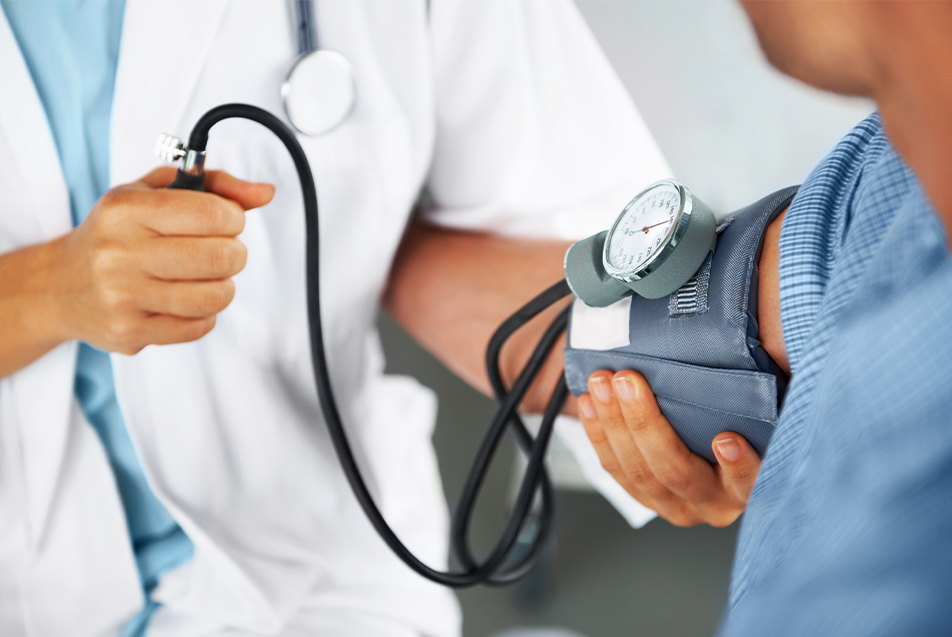
This post was written by Charles Presti, MD, PPG – Cardiology.
Your blood pressure (BP) consists of two parts and is represented by two different numbers displayed as a ratio, like 120/80. The top number, systolic pressure, reflects the force created when the heart squeezes and pumps blood out to the rest of the circulatory system. The bottom number, diastolic pressure, is the pressure in the blood vessels when the heart relaxes between contractions.
It’s been known for many years that systolic and diastolic pressures increase with age, but systolic pressure seems more affected than diastolic pressure. Many also believed that systolic BP was less important than diastolic BP in terms of influencing cardiovascular risk. Consequently, decades ago, a common rule of treatment was that an acceptable systolic BP was 100 plus the patient’s age. This meant that an 80-year-old person’s acceptable systolic BP was less than 180 mmHg! Abundant evidence since that time has clearly shown this rule to be an unacceptable cut-off for treatment and that systolic BP is just as important as diastolic BP in lowering cardiovascular risk.
New guidelines
For the past several decades, the goal of treating hypertension, or high blood pressure, has been to keep BP less than 140/90 mmHg. However, over the past several years accumulating data have demonstrated that even lower numbers provide additional benefits in cardiovascular risk reduction. These lower numbers are expressed in the most recent guidelines for the diagnosis of hypertension, and based on the new definitions, BP is now categorized as:
- Normal: Systolic less than 120 and diastolic less than 80
- Elevated: Systolic between 120 and 129 and diastolic less than 80
- Stage 1: Systolic between 130 and 139 or diastolic between 80 and 89
- Stage 2: Systolic at least 140 or diastolic at least 90
Based on these new definitions, nearly 50% of adults in the United States have hypertension. However, it’s important to keep in mind that BP is affected by many things. Factors like the time of day, physical activity, eating, alcohol intake, medication timing, positional changes and emotional state can influence BP readings. Because of this variability, it’s helpful to monitor your BP at home rather than just relying on a single reading in your doctor’s office. This allows for better assessment of your BP and helps improve treatment.
The consequences of hypertension
Hypertension in and of itself doesn’t usually cause symptoms. However, it is a silent killer because of its relentless effects on vital organs over time, such as the heart, brain and kidneys. Hypertension is one of the leading risk factors for cardiovascular disease, including heart failure, coronary artery disease and peripheral vascular disease. It is also a major risk factor for stroke, the development of chronic kidney disease and dementia. Studies have demonstrated that for every 20 mmHg increase in systolic BP or 10 mmHg increase in diastolic BP, there is a nearly twofold increase in the risk of a fatal cardiovascular event or stroke. Fortunately, hypertension is easy, painless and inexpensive to detect with a simple measurement.
Causes
It’s rare for hypertension to occur based on a single factor. Instead, most people with high BP have what is termed essential hypertension and is likely due to genetic and environmental factors. Some of these factors, like genetics and the aging process, cannot be modified and contribute to the lifetime risk of hypertension. However, on the flip side, factors related to lifestyle, like unhealthy diet and physical inactivity, are amenable to change and can produce significant benefits.
Prevention
When it comes to hypertension, like many things in medicine, prevention is better than treatment. Many of the risk factors for the development and maintenance of hypertension begin early in life, so attempts to prevent and treat the condition should also start early through lifestyle changes. In addition to helping lower BP, these lifestyle changes have the added benefits of also lowering cholesterol, the risk for developing diabetes and certain cancers, and improving overall energy level and mental health. However, for these lifestyle changes to be effective, they need to be life-long, meaning they must be enjoyable and produce meaningful results.
Multiple studies have demonstrated a direct relationship between being overweight or obese and the presence of hypertension. In the United States, about 30-35% of people who are obese have hypertension, nearly twice the prevalence of hypertension in normal-weight individuals. It’s also important to note that these statistics are based on the previous definition of hypertension, a BP of at least 140/90 mmHg. With that said, it’s likely that a much higher percentage of the obese population would be labeled as hypertensive based on the newer guidelines. The good news? Studies have demonstrated that even modest weight loss, 3-5% of your current weight if you are overweight or obese, can help lower your BP. Additionally, if you need to be on medications for hypertension, weight loss improves the effectiveness of these agents.
Dietary modifications are also an essential part of the strategies used to lower BP. Diets rich in fruits, vegetables, whole grains, low-fat dairy products, and lean protein and low in saturated fats and refined sugars are key. It’s also important to limit the intake of dietary sodium and alcohol. Examples of such diets include the DASH and Mediterranean diet.
Finally, regular physical activity and exercise also have many health benefits, including lowering BP. Even moderate physical activity (as little as one day a week) can help reduce the risk of hypertension. Although evidence has shown that aerobic exercise like brisk walking, jogging, biking and swimming provides the most significant degree of BP lowering benefits, resistance training like light weight lifting and sit-ups can prove beneficial too. Remember, it’s important to start slowly, gradually building up to at least 150 minutes of moderate-intensity or 75 minutes of vigorous-intensity aerobic exercise supplemented with at least two sessions of resistance exercises a week. Increasing these numbers will only result in additional health benefits.
Medication
Most people diagnosed with hypertension, especially those with Stage 2, will require pharmacologic therapy and lifestyle changes to achieve adequate BP control. Initiating medical therapy should be a choice made following a shared discussion between you and your health care provider while considering the following factors:
- Your age
- Level of your BP
- Evidence of effects of hypertension on other organs (heart, kidneys or brain)
- An assessment of your overall risk for heart disease and stroke
Depending upon these factors, an initial period of lifestyle modifications may be undertaken for 3-6 months with a reassessment of your BP before deciding to institute pharmacologic therapy. Fortunately, there are well over 100 medications available to treat hypertension, each with its pros and cons. The American Heart Association has an excellent overview of the various classes and possible side effects of antihypertensive medications. Your health care provider will work with you to decide which drug to take bases on your age, race, sex and other underlying medical conditions. The response to a specific medication varies from person to person in terms of efficacy and side effects. For this reason, finding the right drug or drugs since many people require more than one agent to achieve adequate control of their BP may take some time.
Bottom line
Evidence suggests that by making the necessary lifestyle changes mentioned above, you can lower your BP by as much as 10-20 mmHg. This rivals or even exceeds the effects of adding a medication to treat your hypertension. However, when lifestyle changes alone are not enough, medication may be utilized. Through a team approach with your physician, nurse practitioner and dietician, plus the support of family and friends, lowering your BP can be achieved, resulting in a substantial reduction in cardiovascular disease and death.



